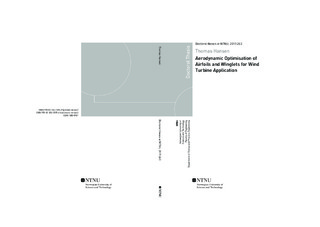| dc.description.abstract | The presented thesis summarises work on applying evolutionary optimisation algorithms for the design of airfoils and winglets for wind turbine application. This approach is more computationally expensive than using traditional design methods, i.e., gradient optimisation, but has the ability to find improved solutions in the multi-modal and rugged solution landscapes often encountered in aerodynamic design. Further, in this work the simulation tools are considered as ‘black-boxes’, where gradient information is difficult to obtain. In this scenario, evolutionary computation is a better approach since derivatives are not required.
The work is divided into three studies. First, the performance of the numerical tools is investigated by simulating a glider aircraft in steady level flight. The simulations are performed by solving the incompressible Reynolds- Averaged-Navier-Stokes (RANS) equations, and to predict the transitional boundary layer flow a correlation-based transition model is applied. Next, an airfoil optimisation method that reduces the loss in performance due to leading edge contamination on wind turbine blades is developed and tested. Here, the aerodynamic coefficients are computed using the panel code XFOIL, and to improve the accuracy, the code is adjusted for wind turbine airfoil flows. The airfoil shapes are optimised using the Covariance Matrix Adaptation Evolution Strategy algorithm, and in order to include constraints, an adaptive penalty function is created. Finally, a winglet optimisation method is developed and tested for a model-scale wind turbine. The turbine performance is simulated by solving the RANS equations and the best performing winglet is obtained by constructing a Kriging surrogate model. To refine the surrogate, an infill criterion based on expected improvement is maximised using a hybrid genetic-gradient optimisation algorithm. The simulated wind turbine performance, both with and without winglets, is validated by performing experiments in the NTNU wind tunnel.
In the first part of the work, it is found that the performance of the glider aircraft is strongly under predicted when the transitional boundary layer flow is not included. This illustrates how important it is to simulate the flow physics correctly. When optimising airfoils and winglets for wind turbine application it is shown that global evolutionary algorithms produce comparable or improved solutions compared to current state of the art. | nb_NO |
